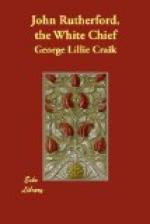The commencement of the coomera harvest in New Zealand is the signal for the suspension of all other occupations except that of gathering in the crop. First, the priest pronounces a blessing upon the unbroken ground; and then, when all its produce has been gathered in, he “taboos” or makes sacred, the public storehouse in which it is deposited.
Cruise states that this solemn dedication has sometimes saved these depositories from spoliation, even on occasion of a hostile attack by another tribe. “One of the gentlemen of the ship,” this writer adds, “was present at the ’shackerie,’[AL] or harvest-home, if it may be so called, of Shungie’s people. It was celebrated in a wood, where a square space had been cleared of trees, in the centre of which three very tall posts, driven into the ground in the form of a triangle, supported an immense pile of baskets of coomeras. The tribe of Teeperree[AM] of Wangarooa[AN] was invited to participate in the rejoicings, which consisted of a number of dances performed round the pole, succeeded by a very splendid feast; and when Teeperree’s men were going away, they received a present of as many coomeras as they could carry with them.” In New Zealand all the cultivated fields are strictly “tabooed,” as well as the people employed in cultivating them, who live upon the spot while they proceed with their labours, and are not permitted to pass the boundary until they are terminated; nor are any others allowed to trespass upon the sacred enclosure.
We have already mentioned more than once the lofty forests of New Zealand. Of these, considered as a mere ornament to the country, all who have seen them speak in terms of the highest admiration. Anderson, the surgeon whom Cook took with him on board the “Resolution” in his third voyage, describes them as “flourishing with a vigour almost superior to anything that imagination can conceive, and affording an august prospect to those who are delighted with the grand and beautiful works of Nature.”
“It is impossible,” says Nicholas, “to imagine, in the wildest and most picturesque walks of Nature, a sight more sublime and majestic, or which can more forcibly challenge the admiration of the traveller, than a New Zealand forest.”
And indeed, when we are told that the trees rise generally to the height of from eighty to a hundred feet, straight as a mast and without a branch, and are then crowned with tops of such umbrageous foliage that the rays of the sun, in endeavouring to pierce through them, can hardly make more than a dim twilight in the lonely recesses below, so that herbage cannot grow there, and the rank soil produces nothing but a thick spread of climbing and intertwisted underwood, we may conceive how imposing must be the gloomy grandeur of these gigantic and impenetrable groves.
[Illustration: Scene in a New Zealand forest.]
In the woods in the neighbourhood of Poverty Bay, Cook says he found trees of above twenty different sorts, altogether unknown to anybody on board; and almost every new district which he visited afterwards presented to him a profusion of new varieties. But the trees that have as yet chiefly attracted the attention of Europeans are certain of those more lofty ones of which we have just spoken.




